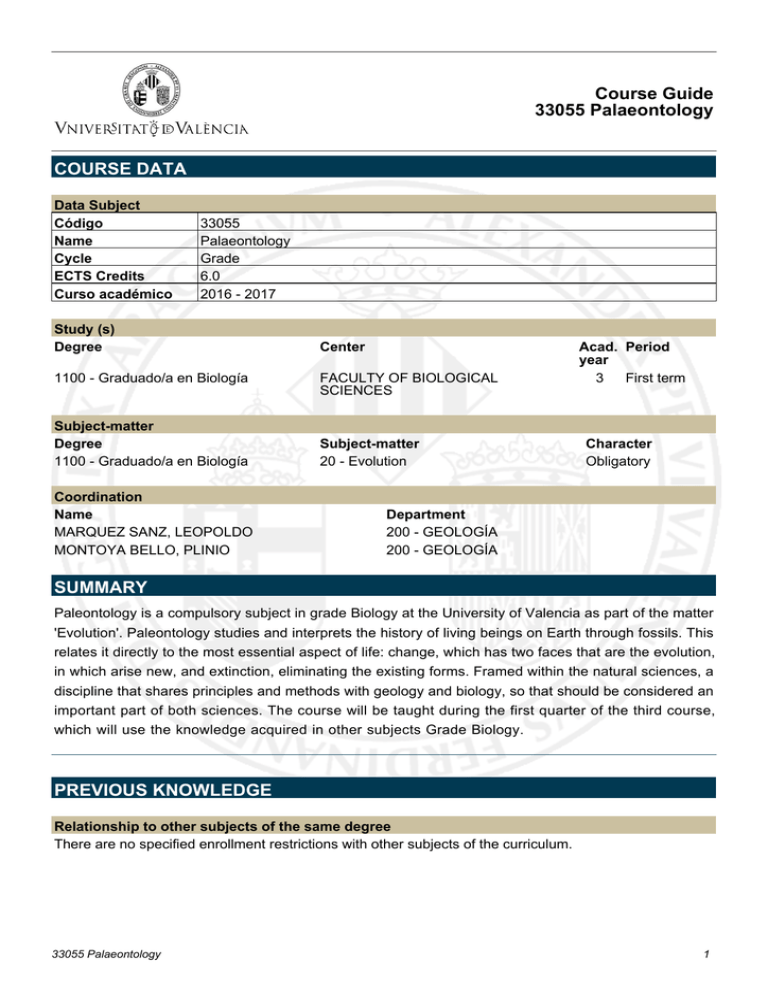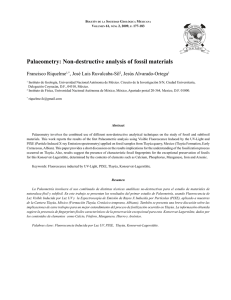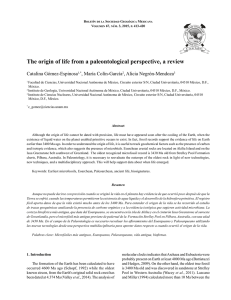Course Guide
Anuncio

Course Guide 33055 Palaeontology COURSE DATA Data Subject Código Name Cycle ECTS Credits Curso académico 33055 Palaeontology Grade 6.0 2016 - 2017 Study (s) Degree 1100 - Graduado/a en Biología Subject-matter Degree 1100 - Graduado/a en Biología Coordination Name MARQUEZ SANZ, LEOPOLDO MONTOYA BELLO, PLINIO Center FACULTY OF BIOLOGICAL SCIENCES Subject-matter 20 - Evolution Acad. Period year 3 First term Character Obligatory Department 200 - GEOLOGÍA 200 - GEOLOGÍA SUMMARY Paleontology is a compulsory subject in grade Biology at the University of Valencia as part of the matter 'Evolution'. Paleontology studies and interprets the history of living beings on Earth through fossils. This relates it directly to the most essential aspect of life: change, which has two faces that are the evolution, in which arise new, and extinction, eliminating the existing forms. Framed within the natural sciences, a discipline that shares principles and methods with geology and biology, so that should be considered an important part of both sciences. The course will be taught during the first quarter of the third course, which will use the knowledge acquired in other subjects Grade Biology. PREVIOUS KNOWLEDGE Relationship to other subjects of the same degree There are no specified enrollment restrictions with other subjects of the curriculum. 33055 Palaeontology 1 Course Guide 33055 Palaeontology Other requirements To take Paleontology must have passed the first year following subjects: Geology, Biology and The Tree of Life. OUTCOMES 1100 - Graduado/a en Biología - Capacidad de análisis, síntesis y razonamiento crítico. - Capacidad de resolución de problemas. - Capacidad de aprendizaje autónomo. - Capacidad de comunicación oral y escrita. - Capacidad de manejar el inglés como vehículo de comunicación científica. - Capacidad de utilizar las nuevas tecnologías de información y comunicación. - Comprender el método científico. - Capacidad de trabajar en equipo y de liderazgo. - Argumentar y razonar en base al conocimiento científico. - Analizar las diferentes formas de abordar problemas científicos complejos. - Comprender la dimensión temporal del origen y evolución de la vida y sus implicaciones. - Comprender la naturaleza histórica del proceso evolutivo en sus aspectos de irrepetibilidad, contingencia y/o necesidad. - Conocer la historia y la cronología de la vida y ubicar los grandes eventos evolutivos en la escala de tiempo geológico. - Conocer los principales conceptos de especie. - Entender los mecanismos de especiación. - Conocer los principales modelos, teorías y evidencias sobre el origen y la evolución temprana de la vida. - Conocer los principios y métodos para la interpretación del registro fósil y su uso en la datación, la reconstrucción paleoambiental y la inferencia de procesos evolutivos. LEARNING OUTCOMES - To distinguish between scientific and pseudo-scientific explanations in evolution. - To apply statistical methods in evaluating scientific hypotheses. - To understand the formation process of a fossil. - To analyze the biological information contained in the fossil record. - To understand the historical nature of evolutionary process in its aspects of uniqueness, contingency and / or need. - To determine the patterns and processes involved in past biodiversity crises and the implications of their study for the analysis of the current one. - To understand the concept of species in paleontology and analyze the mechanisms and patterns of speciation from the fossil record. 33055 Palaeontology 2 Course Guide 33055 Palaeontology - To know the major groups of fossil organisms and their stratigraphic ranges, and their use in paleoenvironmental inference. - To identify the evolutionary relationships among major groups of organisms. - To collect and integrate data from field and laboratory to solve problems in evolutionary biology. - To understand the importance of preserving the Paleontological Heritage as part of the Natural Heritage. DESCRIPTION OF CONTENTS 1. INTRODUCTION Concept and types of fossils. Fossils and sedimentary rocks. The fossil record: bias and representativeness. Paleontology and its subdivisions: taphonomy, paleobiology and applied paleontology. 2. HISTORY OF PALEONTOLOGY. Classical Antiquity, Middle Ages and Renaissance. Seventeenth and eighteenth centuries: the interpretation of fossils as remains of past living beings. Nineteenth and twentieth centuries: the great paleontological controversies: fixists vs. evolutionists and gradualists vs. punctuationists. Paleontology and the scientific method: process-response models. 3. TAPHONOMY. 2. BIOSTRATINOMY. Taphonomy: definition and parts. Biostratinomic processes and factors involved. Formation and types of fossil assemblages. Criteria for recognition in the fossil record. 4. TAPHONOMY. 2. FOSSILDIAGENESIS. Definition and diagenetic stages. Fossilization processes: Consequences of the mineralization of organic remains and their relationship to the types of fossils. Notions on taphonomic theory. Mechanical states of preservation: cumulative, resedimented and reworked entities. Registered entities and their properties. Types of registered assemblages. Introduction to exceptional sites or "lagerstätte." 5. PALEOBIOLOGY. 1. POPULATION BIOLOGY APPLIED TO FOSSIL POPULATIONS. Conceptos básicos: diferencias interpoblacionales e intrapoblacionales y su identificación en el registro fósil. Reconstrucción de dinámicas poblacionales y criterios de identificación de antiguas poblaciones estrategas de r y estrategas de k. Procesos microevolutivos y su estudio en el registro fósil: el caso del ostreido cretácico Agerostrea mesenterica y sus importantes consecuencias evolutivas. 6. PALEOBIOLOGY. 2. THE SHAPE OF ORGANISMS I. 33055 Palaeontology 3 Course Guide 33055 Palaeontology Size and shape: general concepts. Ontogeny in fossils: modes of skeletal growth, isometry and allometry curves and evolutionary sense of the constants a and b. Ontogeny and Phylogeny: heterochrony, causes, consequences, morphological and evolutionary significance. Adaptations: terminology of Skelton, Gould and Vrba. Results and directionality of the adaptations, the adaptative landscapes and its evolutionary consequences. 7. PALEOBIOLOGY. 3. THE SHAPE OF ORGANISMS II. Theoretical Morphology: model analysis of coiled shells of invertebrates and their relationship to adaptive landscapes. Notions of constructional morphology: factors responsible for the shape of organisms. Functional morphology. Reconstruction of the functions of the past organisms: the principle of similarity, biomechanical analysis and paradigmatic method. Examples of functional morphology studies in invertebrate and vertebrate fossils. 8. PALEOBIOLOGY.4. PALEOECOLOGY NOTIONS. Methods of reconstruction of the lifestyles of past organisms. Limiting factors in paleoecology and its study in the geological record. Fossil communities: general concepts and their application to reef communities. Notions of ancient terrestrial communities: trophic pyramids and dinosaur homeothermy. 9. PALEOBIOLOGY. 5. PALEOCLIMATOLOGY AND FOSSIL RECORD. Influence of plate tectonics and climate on the distribution of fossil organisms: climatic gradients. Reconstruction of past climates: paleobotanical, sedimentological and paleozoological data. Problems of geographical distribution of organisms in the past: concepts and examples from the fossil record. Brief description of biogeographic and climatic changes in Earth's history. 10. PALEOBIOLOGY. 6. EVOLUTIONARY PALEONTOLOGY. Introduction to macroevolutionary processes: an overview. The biological species concept and its problems in Palaeontology: time dimension of the species. Fossil record and speciation: punctuated equilibria and phyletic gradualism, examples of both processes in the geological record. Background extinctions (Van Valen Law) and mass extinctions. The rate of organic change: evolutionary rates, types, calculation methods and examples from the fossil record. Evolutionary trends: phyletic and phylogenetic. Its causes and evolutionary consequences. Natural selection of species. Examples. Patterns of evolution: evolutionary radiations, ecological displacement, evolutionary convergences, parallelism, ecological replacement and iterative evolution. Its causes, consequences and examples from the fossil record. General conclusions about evolutionary processes in light of the paleontological record. 11. PRACTICAL AND FIELD. 33055 Palaeontology 4 Course Guide 33055 Palaeontology - Knowledge of the fossil record: 1. Fossils of diploblastic animals: Cnidaria: Rugosa, Tabulata and Scleractinia. - Knowledge of the fossil record 2. Fossils of triploblastic animals. 1. Mollusca. Importance of their fósil record. Gastropoda: Major fossil groups. - Knowledge of the fossil record: 3. Fossils of triploblastic animals. 1. Mollusca. Bivalvia: fossil groups and their various lifestyles. - Knowledge of the fossil record: 4. Fossils of triploblastic animals. 1. Mollusca. Cephalopoda: Main groups: Orthoceratoidea, Nautiloidea and Ammonoidea. Its importance in the fossil record. - Knowledge of the fossil record 5. Fossils of triploblastic animals. 2. Brachiopoda. Convergence with bivalve molluscs and distinction from the shells of both groups. External morphology and significance of the internal characters. - Knowledge of the fossil record: 6. Fossils of triploblastic animals 3. Arthropoda. Study focused on Trilobitomorpha and other fossil groups. - Knowledge of the fossil record: 7. Fossils of triploblastic animals. 4. Echinodermata. Paleozoic diversity and current diversity. The various fossil groups with special attention to the Echinoidea. - Knowledge of the fossil record: 8. Fossils of triploblastic animals. 5. Vertebrata. Recognition of different types of vertebrates. Observation of bones and teeth of mammals. - Paleoichnology: The ichnites and their importance in geology and paleontology. Classification and ichnofacies. Ethological and paleoenvironmental inferences. - Micropaleontology. Preparation techniques and major groups of microfossils: Protista (Foraminifera, Radiolaria, etc.) Porifera, Arthropoda (Ostracoda) and Vertebrata (mammals and conodonts). - Practice Field: methodical observation of the fossil record at different outcrops and reconstruction of the geological history of the visited area. 12. SEMINARS. It may develop joint seminars for the subjects taught in third grade and seminars proposed by the subject (whose details and development are indicated appropriately). WORKLOAD ACTIVITY Theory classes Laboratory practices Tutorials Study and independent work Preparing lectures Preparation of practical classes and problem Resolution of case studies TOTAL Hours 31.00 28.00 1.00 47.00 30.00 10.00 3.00 150.00 % To be attended 100 100 100 0 0 0 0 TEACHING METHODOLOGY The course is based on the use of different learning activities which include: 33055 Palaeontology 5 Course Guide 33055 Palaeontology • Lectures. The development of the course is divided into two lectures a week. In them, the teacher will present the fundamental concepts of each of the topics, using appropriate audiovisual resources which give access to students by the usual means. During the sessions, students will focus on adequate documentation and resources used for the study and understanding of the concepts and correlate them with the seminar and / or conference, included in the schedule of the course. • Practical classes. Practice sessions will be lab (10), laboratory sessions, 2 hours, will include an introduction in which the teacher discusses general aspects of the group of organisms studied and the rest of the time will be spent by students to make the practice under the supervision of the teacher. A session is a practical field trip. Lasts 8 hours effective and teacher / teachers introduce students to the methodical observación of the fossil record in different outcrops and geological and paleontological conclusions derived from this observation. • Seminars. Were raised 2-hour seminar for attending a conference on topics of interest in paleontology. • Small group tutorials. These tutorials will be used to discuss issues and / or concerns related to the subject. Also be used for the review and preparation of the matters covered by the final exam. Is scheduled one hour of tutoring in small groups. • Individual tutorials. The teacher will schedule the student assistance, which may use whenever they deem necessary. Within this timetable is expected that students, individually, to attend at least three times during the semester to address specific questions or concerns about the content of the course. EVALUATION Monitoring in theory be made by means of an exam at the end of the course, in the date proposed by the Faculty, which count as 2/3 of the final grade. It will be indispensable to pass the course, reaching at least a score of 4.5 out of 10 in this exam. The assessment of the practices carried out through the final exam will consist of a visu recognition test of the fossil groups studied, with questions about taxonomic and taphonomic aspects. The memory of the field trip and/or questionnaire conducted after the same will contribute 20% of the final practices. Therefore, the whole practice mark will be a 1/3 of the course. Summary table: Subject to evaluate % of final grade Theoretical exam 2/3 Practical test and field trip 1/3 Finally, to pass the course must have earned a 4.5, at least in each of the two main sections, and the weighted average of the two main points should exceed the rating of 5. 33055 Palaeontology 6 Course Guide 33055 Palaeontology In the case of repeaters, if the previous year had passed a part of the course (theory, practice) the note of these parts are kept for one academic year, but will have to take exams or perform work for the part having suspended the previous year. REFERENCES Basic - BENTON M.J. & HARPER D.A.T. 2009. Introduction to Paleobiology and the Fossil Recod. WileyBlackwell Ed., 592 pp. - DOMÈNECH, R. y MARTINELL, J. 1993. Introducción a los fósiles. Masson: 298 pp. - FOOTE, M. & MILLER, A.I. 2007. Principles of Paleontology. W.H. Freeman & Cº, New York, 354 pp - LIEBERMAN, B. S. & KAESLER, R. 2010. Prehistoric life. Evolution and the fossil record. WileyBlackwell Ed., 385pp. - RAUP, D.M. & STANLEY, S.M. 1978. Principles of Paleontology (2ª edición). W.H. Freeman and Company. 481 pp. San Francisco. Existe traducción de la 1ª edición (1971), bajo el título Principios de Paleontología, Ed. Ariel, Barcelona. Additional - AGUIRRE, E. Ed. 1989. Paleontología. Nuevas tendencias. Consejo Superior de Investigaciones Científicas. Madrid: 433 pp. - AGUSTÍ, J. 1994. La evolución y sus metáforas. Una perspectiva paleobiológica. Tusquets: 211 pp. - AGUSTÍ, J. 1995. Els fòssils. A la recerca del temps perdut. Edicions de la Magrana: 187 pp. - ANTÓN, M. 2007. El secreto de los fósiles. El arte y la ciencia de reconstruir a nuestros antepasados (y otras criaturas). Aguilar: 359 pp. - BRIGGS, D.E.G. & CROWTHER, P.R. eds. 1990. Palaeobiology. A synthesis. Blackwell Science, Oxford. 583 pp. - BRIGGS, D.E.G. & CROWTHER, P.R. eds. 2003. Palaeobiology II. Blackwell Science, Oxford. - BUFFETAUT, E. 1992. Fósiles y hombres. Plaza & Janés: 356 pp - COWEN R History of Life.(2007) , 4th. ed. Blackwell Ed. - DOMÈNECH, R. I MARTINELL, J. 1993. Introducció als fòssils. PPU: 298 pp. - ERWIN, D.H. & WING, S.L. (eds.) 2000. Deep time. Paleobiologys perspective. 373 pp. (suplemento del volumen 26(4) de la revista Paleobiology). The Paleontological Society. Kansas, EE.UU - FERNÁNDEZ LÓPEZ, S. 1998. Tafonomía y Fosilización. In: Tratado de Paleontología. Tomo I (ed. por B. Meléndez), pp. 51-107. Colección Textos Universitarios, C.S.I.C. Madrid. - FERNÁNDEZ LÓPEZ, S. 2000. Temas de tafonomía. 167 pp. Edita Depto. Paleontología, Universidad Complutense. Madrid. - FORTEY, R. 1999. La Vida. Una biografía no autorizada. Taurus: 517 pp. - GÓMEZ-ALBA, J.A.S. 1988. Guía de Campo de los Fósiles de España y de Europa. Ediciones Omega: 925 pp. - GOULD, S.J. 1991. La vida maravillosa. Burgess Shale y la naturaleza de la historia. CríticaDrakontos: 357 pp. - GOULD, S.J. (ed.) 2001. El libro de la Vida. Editorial Crítica: 320 pp. - LÓPEZ MARTÍNEZ, N. 1986. Guía de campo de los fósiles de España. Ed. Pirámide: 479 pp. 33055 Palaeontology 7 Course Guide 33055 Palaeontology - LÓPEZ MARTÍNEZ, N. y TRUYOLS SANTONJA J. 1994. Paleontología. Ed. Síntesis. Madrid: 334 pp. - RUDWICK, M.J.S. 1987. El significado de los fósiles. Episodios de la historia de la Paleontología (Traducció 2ª ed. anglesa, 1976). Hermann Blume, Serie Ciencias de la Naturaleza, 347 pp. Madrid. - SIMPSON, G.G. 1985. Fósiles e historia de la vida. Prensa Científica: 240 pp. 33055 Palaeontology 8

